Warehouse Storage Systems
Types of warehouse storage systems are varied and getting to know its different types will help you to determine which type to choose for storing your items.
 |
| Types of warehouse storage systems. |
Types of Storage Methods in a Warehouse
Each storing system type will answer a specific need and functionality of the warehouse. These types can undertake the following forms:
- Loose Storage
- Binned Storage
- Shelved Storage
- Block Stacking
- Pallet Storage System
Loose storage: Items are stored in loose pallets on the floor (e.g. heavy pumps and generators).
Binned storage: Bins are used for storing particular items and are a good method of storing a large number of small items in a compact area.
Bins can be plastic containers that either hang from shelves or are loose standing on shelves. The variety and size of bins change and designs can be selected for certain types of items.
Shelved storage: Shelves (or racking) can be used to store bins as well as larger items up to specific heights. Shelves are a compact method of storing small (normally in bins) to medium (normally on pallets) size items.
The weight of items that can be stored on the shelves depends on the type of shelving used.
Block stacking: The most frequently used method of storing large quantities of items. Large quantities of goods are normally stored on pallets on the floor of the warehouse.
Items are packed in unit loads, and stacked to their maximum safe height, which depends on the weight and stability of the unit packages.
Pallets Storage System: Pallets are wooden slatted platforms (usually with an area of 1m2), which can be bought or constructed from wooden boards or plastic.
Pallets keep goods off potentially damp floors. They make stacking easier and are essential when lifting/moving equipment is used.
Types of warehouses
There are many types of warehouses, which can be used for several reasons such as Storing goods until needed.
However, there are many types of warehouses that can be used for storing products such as:
- Commercial Warehouse
- Government Warehouse
- Owned Warehouse
- Transit Warehouse
- Prefabricated Warehouse
- Tents or Rubhalls
- Freight Container Storage
- Bonded Warehouse
- Open Storage
Commercial Warehouse: in a rented building used for business.
Government or state Warehouse: such as at the ports or harbors. This is common in emergency situations.
Owned Warehouse: space that is owned and managed by the organization.
Transit Warehouse: for the temporary storage of goods destined for different locations that need storing for a very short time.
Pre-fabricated warehouses: where there are no permanent structures available; a common practice in emergencies.
Tents or Rubhalls: for storage in the field. They are often used as temporary structures at the start of an emergency.
They require fencing, and trenches as their entry can easily be breached.
Freight Container Storage: is used to store relief items.
Bonded warehouses: for storage of goods whose duty is unpaid and particularly where the goods are destined for another country. They are also used to keep stock without paying duties on them.
Duties are paid once the goods are imported into the country. As long as they stay in bonded warehouses they do not incur duties.
Pre-positioned stock is often held in warehouses so that it can be quickly exported.
Open storage: not ideal for perishable products, but in emergencies is sometimes the only alternative.
Conclusion:
Selecting the best type of warehouse and storage systems is crucial to getting the best storage for your products. By reading this article, you will really get to know each type that suits your items. different ways and have different forms.
You can also read more about warehouse storage management.

